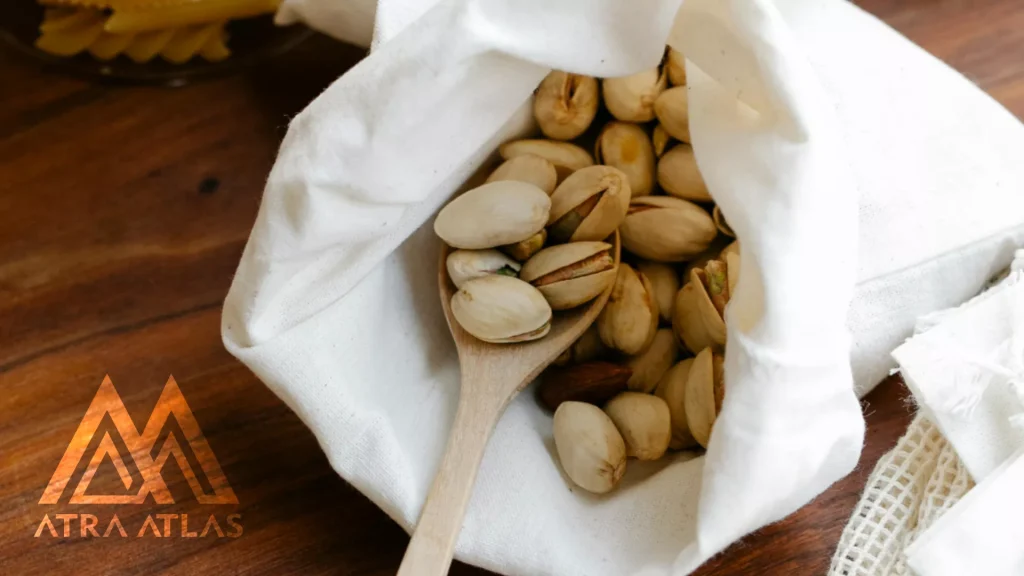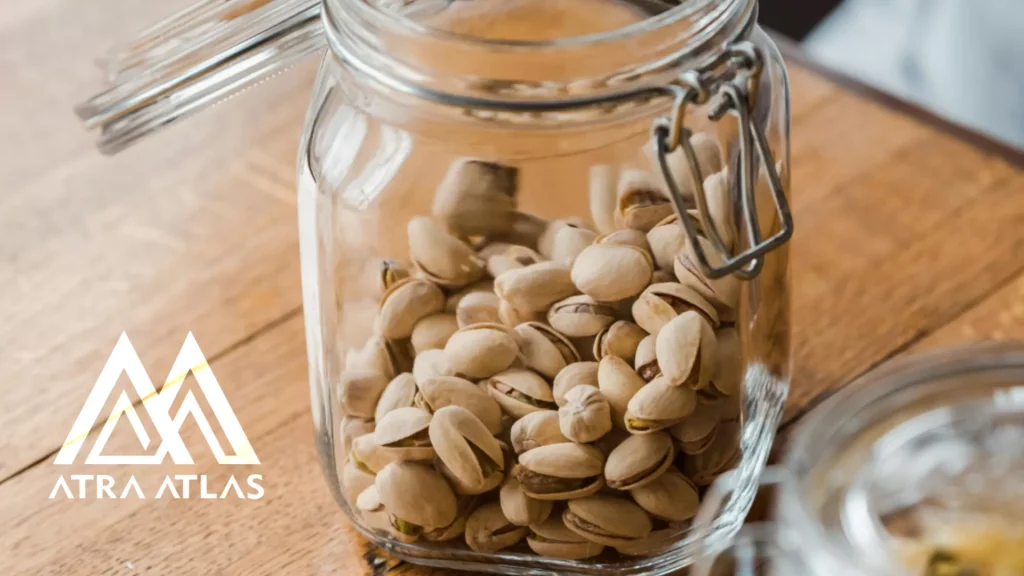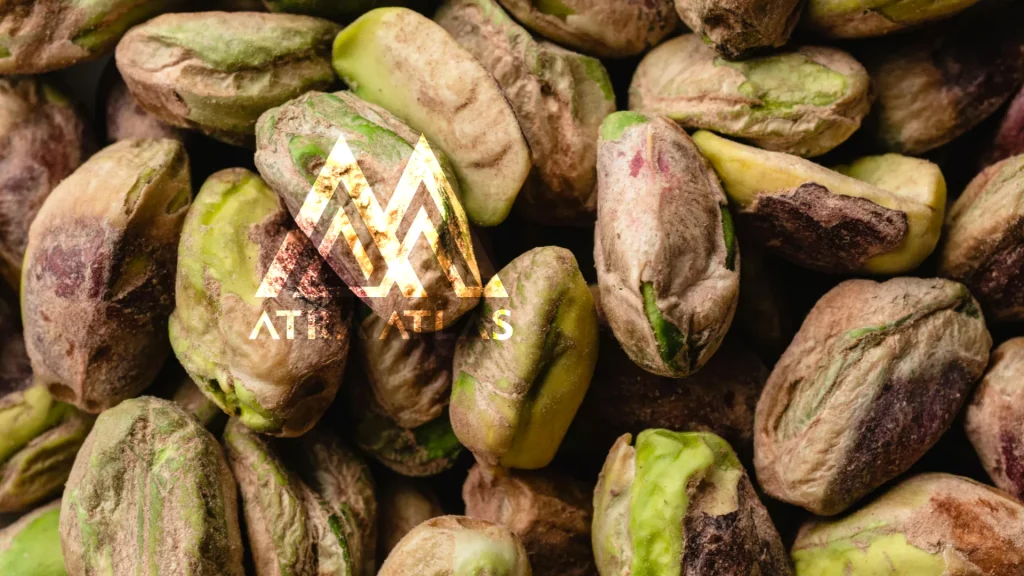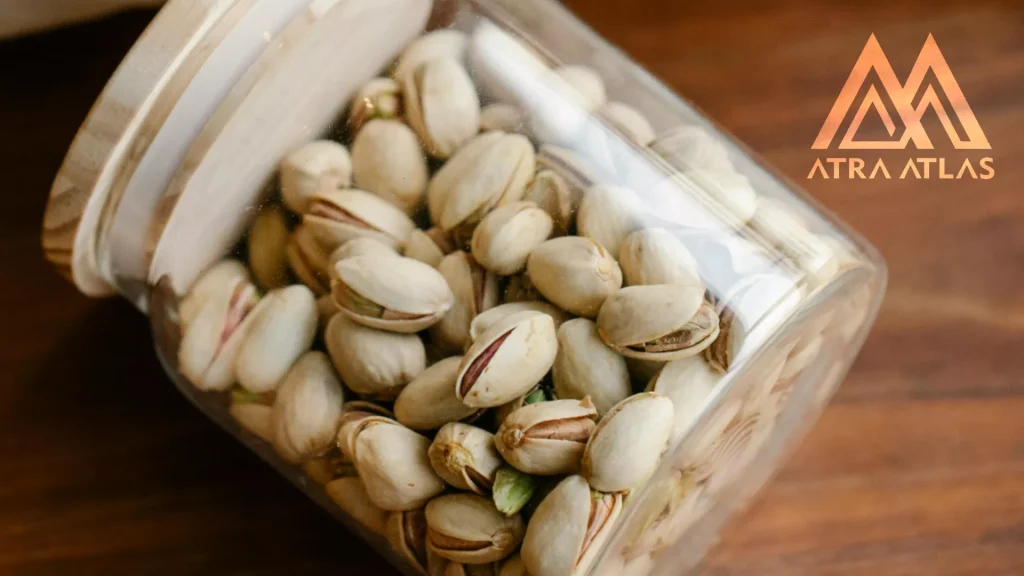
Iranian pistachio
With its delicious taste and unique characteristics, Iranian pistachios are renowned not only as a tasty treat but also as a rich source of energy and essential nutrients in human nutrition. The importance of pistachios in nutrition arises from their exclusive composition.
Iran offers various types of pistachios, each with distinct taste and appearance characteristics.
Pistachios are an excellent source of protein, fiber, vitamins, and minerals such as magnesium, phosphorus, and potassium. This dried fruit provides a balanced combination of healthy and unhealthy fats, beneficial for the heart, brain, and immune system.
Pistachios have earned their place as one of the most popular, nutritious, and delicious nuts globally, with many fans worldwide. Iran stands as the top and best producer and exporter of various types of pistachios in the world.
The Most Famous Types of Pistachios in Iran and Their Names
In Iran, there are several famous and popular types of pistachios, including Akbari pistachios, Ahmed Aghaei pistachios, Fandghi (Ohadi), and Kaleh Gouchi pistachios.
In general, the price of each type of these pistachios may vary depending on various factors such as quality, size, shape, and market.
Akbari pistachio is one of the most popular types of pistachio in Iran. This type of pistachio has an almond-like shape and is oval-shaped. Akbari pistachios are large and have the highest economic value and price among all types of pistachios.
The taste of this pistachio is usually sweet and delicious, with an outer skin that is dark cream and smooth. Akbari pistachio is often exported as the most valuable type of Iranian pistachio and is available in both domestic and foreign markets.
The harvest time for Akbari pistachio is from the 11th to the 21st of September, making it a late-season variety. This type was originally identified and propagated in Rafsanjan city.
2- Pistachio Ahmad Aghaei
Ahmad Aghaei pistachio is one of the most famous types of pistachios in Iran. This pistachio has an elongated almond shape and a red core. The shell is white and elongated.
Ahmad Aghaei pistachio is average in size among pistachios, and its price is usually average and lower than Akbari pistachio. The taste is delicious and creamy, gaining many fans for its flavor. Ahmad Aghaei pistachios are also very popular in world markets.
3- Hazelnut pistachio
Hazelnut pistachio, also known as Ohadi pistachio, has a smaller and rounder appearance than Akbari and Ahmad Aghaei pistachios. The taste of this pistachio is rich and delicious, making up 60-70% of Iranian pistachio production.
The hazelnut kernel is smaller and rounder than the almond pistachio, with a more brown inner core. This type of pistachio is often used in Iran as a raw material in the production of sweets, ice cream, and other food products.
The outer skin of hazelnut pistachios is often creamy and bone-like. Their price is usually lower than the previous two types of pistachios. Hazelnut pistachios are popular for occasions such as Eid and Yalda due to their smaller size and higher quantity per kilogram.
Hazelnut pistachios were first identified and introduced in Rafsanjan city. Today, about 60% of pistachios in Rafsanjan are of the hazelnut type.
Hazelnut pistachios are suitable for many regions in Iran compatible with pistachio cultivation, leading to their expanded cultivation in provinces such as Yazd, Razavi Khorasan, Markazi, Qazvin, Fars, and Tehran.
4- Ram head pistachios
Kole Ghochi pistachio, also known as Ram head pistachio, is one of the most famous pistachios in Iran. It has a round and large appearance, contributing to its higher price compared to other pistachios. The taste is sweet and delicious, with an outer skin that is white and slightly dark.
The large size and appearance of this pistachio have made it popular both domestically and internationally. It is exported in large quantities to European countries due to its look and flavor.
Kole Ghochi pistachios are mainly cultivated in Kerman province and are spread across other provinces. This pistachio is usually harvested from the 11th to 20th of Shahrivar month and is known as a medium maturing variety.
5- Shah Pasand Damghan Pistachio
As its name suggests, Shah Pasand pistachio is one of the most famous commercial pistachios of Damghan city. This pistachio has a delicious taste and is recognized as one of Iran’s first-class pistachios.
Shah Pasand Damghan pistachio has an almond-shaped fruit, large size, and unique taste. Competing with Akbari pistachio, Shah Pasand has a smiling appearance (split shell) and a large kernel, yet its price is more affordable than its competitor.
6- Daggered pistachios
All kinds of Iranian pistachios are cultivated in Damghan city, and as the name suggests, it has an elongated arc on one side like a dagger. In terms of appearance, it is similar to Ahmed Aghaei pistachio and Badami pistachio. This type of pistachio has a lower price compared to Akbari pistachio and Kole Ghochi
7- Pistachio almonds
Almond pistachio, as its name suggests, has an almond-shaped and elongated appearance. Badami pistachios are smaller than Ahmad Aghaei pistachios.
The birthplace of these pistachios is Zarand city in Kerman province, and also in Khorasan. This pistachio variety has a lower price than both Kaleh Ghochi and Ahmad Aghaei varieties. Since almond pistachio flowers early and is harvested in early August, it is one of the so-called “very early ripening” items.
8- Premium pistachios
Premium pistachio, also known as Zarand pistachio, comes from Zarand city in the northwest of Kerman province. The main economic activity in this city is agriculture, leading to significant progress in the production and harvesting of pistachios.
Premium pistachios have a tastier kernel than other commercial pistachios exported worldwide. The premium pistachio fruit is almond-shaped with an elongated appearance. The core is red, and the skin is light bone.
The superiority of each type of pistachio depends on individual taste and different applications:
Akbari pistachios: Ideal for foods and nut combinations due to their larger size and pleasant taste.
Ahmad Aghaei pistachios: Suitable for snacks and sweets with their good taste and medium size.
Hazelnut pistachios: Widely used in the production of sweets and ice cream due to their smaller size and high consistency.
Kole Ghochi pistachios: Used in nuts for catering and making sweets as they are large with a delicious taste.
Characteristics of High-Quality Pistachio and its Detection Method
Due to the high popularity of pistachios worldwide, many people seek to buy the best and highest quality types of Iranian pistachios. To recognize a high-quality pistachio, consider these tips and features to ensure you purchase healthy and delicious pistachio nuts:
Dimensions and appearance: High-quality pistachios often have a larger size and a more regular shape. Their appearance is usually oval or round.
Color: The color of a quality pistachio should be uniform and fresh. The outer skin should be smooth and free of damage or spots. Any dark spots or unusual marks greatly reduce the quality of the pistachios.
Taste and aroma: High-quality pistachios should have a delicious, mild, and pleasant taste. Their aroma should be aromatic and oily. Avoid pistachios that taste bitter, have an unpleasant aroma, or lack flavor.
Humidity: High-quality pistachios must have proper humidity. Abnormally dry or wet pistachio nuts can indicate poor quality or improper storage.
Shell: In high-quality pistachios, the green parts on the shell should be minimal.
Place of production: High-quality pistachios are usually harvested from areas with suitable weather conditions. Regions like Kerman and Khorasan are often known for producing higher quality pistachios.

The Most Important Differences Between Iranian Pistachios and Foreign Pistachios
Iranian pistachios are produced in areas with a dry and desert climate. These special weather conditions give Iranian pistachios a notably good taste and quality. In contrast, foreign pistachios are produced in different regions of the world with varying weather and soil conditions.
The main difference between Iranian pistachios and foreign pistachios lies in the climate of their production regions. These differences directly impact the characteristics and quality of pistachios. Iran has a dry and desert climate, with many production areas experiencing hot and dry summers and cold winters.
Regions such as Kerman, Khorasan, Yazd, and Sistan and Baluchistan provinces are notable for Iranian pistachio production. These areas have weather conditions that are particularly suitable for the optimal growth and development of pistachios.
Foreign pistachios are produced in various regions, including America, Turkey, Syria, Italy, and Greece. These regions often have more humid and moderate climates compared to Iranian pistachio production areas.
The most important climatic difference between Iranian pistachios and foreign pistachios is related to the climatic and soil conditions of their production areas. These conditions can affect the growth, taste, texture, and quality of pistachios.
– Difference in taste
The taste of Iranian pistachios is one of their most prominent features. The special climatic conditions in the production areas contribute to the distinct flavor of Iranian pistachios. The genetic diversity of Iranian pistachios also adds to the variety in their taste. Foreign pistachios also have varied tastes depending on the region of production.
Foreign pistachios generally have a milder taste compared to Iranian pistachios and often lack a rich flavor. This difference may be due to variations in climatic conditions, soil, and genetic diversity. Other factors such as processing methods, storage conditions, and harvest time can also affect the taste of pistachios.
– Difference in product variety
Iranian pistachios exhibit a remarkable variety. As one of the largest producers of pistachios globally, Iran produces various types. Foreign pistachios tend to have less variety.
This diversity can be attributed to factors like genetic diversity, size, shape, and other characteristics. Iranian pistachios are known for their extensive diversity in comparison to others.
In Iran, high genetic diversity has resulted in the production of different types of pistachios. Iranian pistachios come in various sizes and shapes, each with unique characteristics. While foreign pistachios can also exhibit variety, they usually have less diversity than Iranian pistachios. Based on growing regions, foreign pistachios can be categorized into California, Antpersian, Cires, and Evangels types.
– The difference in pistachios
In general, Iranian pistachios have a very low porosity percentage, which means they have a full kernel and a firm shell. On the other hand, some foreign pistachios may have a higher percentage of porosity.
Regarding pitted pistachios, note that this characteristic depends on various factors like the type of pistachio, growing conditions, and processing methods, and cannot be generally attributed to Iranian or foreign pistachios.
Therefore, this difference cannot be explicitly generalized for both types of pistachios. Factors such as harvesting, storage, and processing methods may affect pistachio quality. However, due to special climatic conditions and higher quality standards, Iranian pistachios generally have a much lower percentage of porosity and imperfections compared to foreign pistachios.
– The difference in heating ability
Iranian pistachio enhances quality and taste significantly in cooking processes such as the production of doughs and pastries through heat absorption, giving a great taste and texture to sweets, cakes, and food. It is usually considered one of the best options for baking baklava due to its high heat capacity.
This characteristic is due to the high oil and fat content, allowing pistachios to maintain their state and quality during cooking processes, creating a good taste and aroma in various foods and sweets. When Iranian pistachios are cooked in baklava or other foods, their natural oil is released through contact with heat, enhancing taste and aroma, and improving the quality and flavor of baklava or other dishes.
– Racial difference:
Due to their special taste, Iranian pistachios are in high demand worldwide. Iranian pistachios have a sweet and fatty flavor. The genetic diversity and different types of pistachios are the most important factors that distinguish Iranian pistachios from foreign pistachios.
– The pistachio kernel is higher than the whole pistachio:
Iranian pistachios have more kernels compared to foreign pistachios. This means that if you purchase packages of both Iranian and foreign pistachios for the same amount, you will get more kernels from Iranian pistachios.
– Difference in exports
Iranian pistachio is recognized as one of the best examples of pistachio in the world, accounting for the largest amount of pistachio export. Iranian pistachios hold a very strong position in the global export industry and are known for their quality in the international market. The weather conditions and suitable soil in Iran contribute to the best quality among pistachios. These pistachios have excellent taste, aroma, and texture, praised by exporters and global buyers.
As one of the largest producers and exporters of pistachios globally, Iran has a long history and experience in exporting pistachios. Iranian pistachios offer competitive and reasonable prices due to high production and the competitiveness of the export market. This gives Iranian pistachios a stronger position in the world market.
For this reason, Iranian pistachios are exported using international standards and are known as a quality and safe product.
The Price Difference Between Iranian and Foreign Pistachios
When examining the price of Iranian pistachios compared to foreign pistachios, it’s important to note that prices can be affected by various factors and may vary in different markets or over time. Iranian pistachios usually have a relatively reasonable price due to factors such as high production, export experience, and competitive pricing.
Iran stands as one of the largest producers of pistachios globally, with its high production allowing the country to supply pistachios to global markets on a large scale. This high production rate can lead to better prices for Iranian pistachios. Competitive pricing among pistachio producers in world markets typically results in more reasonable prices. Iranian pistachios generally have more reasonable prices due to high production and competition with other countries.
As one of the main producers of pistachios in the world, Iran has strong commercial connections with global markets. These connections help reflect the price of Iranian pistachios directly and without intermediaries, preventing sudden price increases.
Pistachio producing areas in Iran
Kerman: This province is one of the main pistachio production areas in Iran. It is famous as the hub of pistachio production in Iran. The cities of Rafsanjan and Sirjan in this province are known as the main pistachio production centers in this region.
Khorasan: The cities of Birjand, Faizabad, and Qaenat in Razavi Khorasan and South Khorasan provinces are famous as other pistachio production points in this province.
Yazd: Meibod and Mehriz are important pistachio production cities in Yazd province.
Fars: The cities of Raz and Jarglan in Fars province are also engaged in the production of authentic pistachios.
Semnan: Damghan is known as one of the important pistachio production and processing points in Iran, facilitated by the region’s suitable climatic and soil conditions.
Sistan and Baluchistan: In this province, the city of Zahedan is known as one of the pistachio production areas.

Iranian Pistachio Tree Rooting:
The root of the Iranian pistachio tree is axial and vertical, reaching a depth of more than two meters into the soil. The ability to produce secondary roots in the Iranian pistachio tree is very weak, and if the end of the main root is cut, the tree dries up and dies. The Iranian pistachio tree has a habit of vertical growth. The origin of pistachio trees traces back to a region within the territory of Iran.
Iranian pistachio, a seed that comes to fruit:
The propagation method of the Iranian pistachio is through planting seeds and creating seedlings, and pistachios have been cultivated in Iran for a long time.
Different methods of planting Iranian pistachio seedlings include:
Planting in the main land
Planting in the treasury
Planting in plastic bags
With its delicious taste and unique characteristics, Iranian pistachio is known not only as a delicious food but also as a rich source of energy and essential nutrients in human nutrition. The importance of pistachios in nutrition is due to the unique composition of its components.
General Strengthening of the Body with Iranian Pistachio Nuts:
The pistachio kernel, forming the edible part, is green with a light brown skin that does not need to be removed before eating.
Pistachio nuts have a warm nature and have been enjoyed by humans since ancient times as a pleasant, useful, and energizing food. Later, they were incorporated into various recipes.
Pistachio kernels are prescribed for general strengthening of the body and are known to generate blood and stimulate the body’s active forces.
Characteristics of Standard Pistachio Shells:
Skin color: Pistachio skin color refers to the natural color of the hard, bony shell of raw pistachio, varying from milky to dark cream depending on the type of pistachio and processing method.
In elongated pistachio varieties, colored smoky dots and lines can be seen at the end of the outer shell, which is normal.
The color of processed pistachio skin (e.g., roasting) can vary depending on the processing type.
Bad color of the pistachio shell occurs when the natural color is lost due to unfavorable processing conditions, visible on a quarter of the whole surface or half of one edge.
The acceptable amount of bad color in pistachio standards varies by type, but generally, in premium to excellent grade pistachios, it can be a maximum of 2% of the total pistachios.
Pistachio shape: In standard pistachios, the shape should be natural and symmetrical. If pistachios lose their symmetrical and natural shape due to reasons like incomplete growth or breaking during mechanical milling, they are considered malformed.
In pistachio standards, up to 5% of pistachios can be malformed, though this amount varies based on the pistachio grade.
Smiling pistachio: A pistachio with a hard, bony shell gap allowing easy access to its kernel is a smiling pistachio. The degree of the gap (smiling, less smiling, nail-shaped) is a crucial factor in determining pistachio quality and price.
In pistachio standards, a maximum of 6% of the seeds can be smiling pistachios or partially smiling pistachios. In a standard load of pistachios, the maximum amount of unripe pistachios and shells can be 8% of the seeds.
Pistachio shell: A pistachio whose first skin (soft skin) hasn’t been removed or covers more than one-eighth of the entire surface of the hard, bony shell.
Unripe pistachio: A pistachio whose kernel hasn’t fully grown, or remains small. In this case, the pistachio kernel contains less than 47% and more than 25% of the pistachio’s weight.
Characteristics of standard pistachio nuts
Standard pistachio nuts do not have any unnatural or spicy smell and taste. Any unusual taste apart from the natural taste indicates chemical reactions in the pistachio kernel compounds or contamination. Standard pistachios should also be free of burnt smell and taste, often caused by processing under unfavorable conditions, such as high temperature or long duration.
Color of the pistachio: Each variety can have its unique color; in general, standard pistachios are classified into four color categories: green, yellowish green, yellow, and mixed.
Moisture level: One key factor influencing pistachio texture and crispiness is its moisture level. This should generally be no more than about 6.5%; however, some countries have different standards. For example, in the United States, the limit is about 7%.
In standard pistachios, the maximum amount of free pistachio kernels can be 1% of the weight.
The pistachio kernel or its part that has come out from inside the hard shell is called a free pistachio kernel.
The amount of peroxide extracted from pistachio kernels should be at most 1 milliequivalent per kilogram.
Aflatoxin in standard pistachios is limited to 15 ppb for the whole nuts and 5 ppb for type B1 at most.
The moisture content (the amount of water in the pistachio kernel) should be a maximum of 6% of the seeds.
In standard pistachios, no live pests should be observed, and up to 5% of the seeds can be infected, provided the amount of moldy seeds is not more than 0.2% of the seeds.
Pistachio pest: This refers to contamination or damage caused by pest activity, including droppings, eggshells, larvae, pupae, mold, fungi, and holes from insect feeding (usually seen after removing the third skin). These can be visible to the naked eye on the pistachio kernel.
Uniformity of pistachio varieties: Pistachio is considered uniform in terms of size and variety. A pistachio bar that lacks these characteristics is considered mixed (with lower quality and price).
Uniformity in size: Pistachios are considered uniform in size when the weight ratio of 15% of the largest grains to 15% of the smallest grains is 1.5 at most.
Uniformity in variety: Pistachios are considered uniform in variety when a maximum of 6% of the seeds are different from another variety.
Foreign materials: Materials other than pistachio, such as pistachio green skin, bony and hard skin without core, pebbles, smiling puck, etc., are visible to the naked eye and can be separated by different methods.
The maximum amount of foreign materials can be 1%, provided that the amount of foreign materials other than pistachio skin is not more than 0.3%.

To import pistachios from Iran, you can leverage the advice and experience of Atra Atlas Trading Holding.
